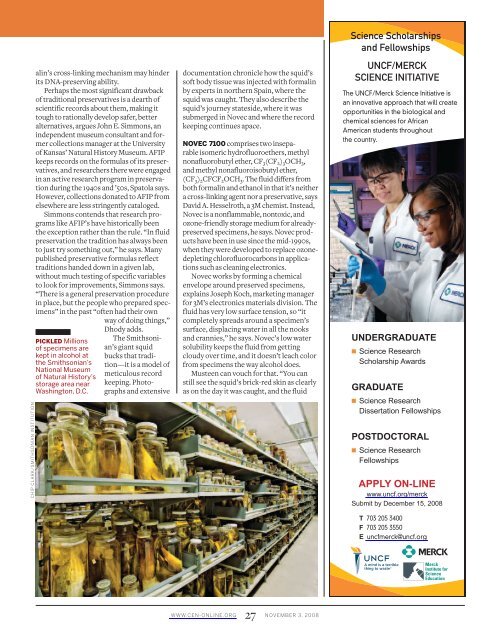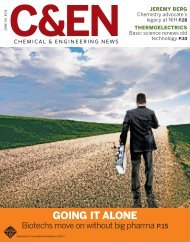Chemical & Engineering News Digital Edition ... - IMM@BUCT
Chemical & Engineering News Digital Edition ... - IMM@BUCT
Chemical & Engineering News Digital Edition ... - IMM@BUCT
Create successful ePaper yourself
Turn your PDF publications into a flip-book with our unique Google optimized e-Paper software.
CHIP CLARK/SMITHSONIAN INSTITUTION<br />
alin’s cross-linking mechanism may hinder<br />
its DNA-preserving ability.<br />
Perhaps the most significant drawback<br />
of traditional preservatives is a dearth of<br />
scientific records about them, making it<br />
tough to rationally develop safer, better<br />
alternatives, argues John E. Simmons, an<br />
independent museum consultant and former<br />
collections manager at the University<br />
of Kansas’ Natural History Museum. AFIP<br />
keeps records on the formulas of its preservatives,<br />
and researchers there were engaged<br />
in an active research program in preservation<br />
during the 1940s and ’50s, Spatola says.<br />
However, collections donated to AFIP from<br />
elsewhere are less stringently cataloged.<br />
Simmons contends that research programs<br />
like AFIP’s have historically been<br />
the exception rather than the rule. “In fluid<br />
preservation the tradition has always been<br />
to just try something out,” he says. Many<br />
published preservative formulas reflect<br />
traditions handed down in a given lab,<br />
without much testing of specific variables<br />
to look for improvements, Simmons says.<br />
“There is a general preservation procedure<br />
in place, but the people who prepared specimens”<br />
in the past “often had their own<br />
way of doing things,”<br />
Dhody adds.<br />
PICKLED Millions<br />
of specimens are<br />
kept in alcohol at<br />
the Smithsonian’s<br />
National Museum<br />
of Natural History’s<br />
storage area near<br />
Washington, D.C.<br />
The Smithsonian’s<br />
giant squid<br />
bucks that tradition—it<br />
is a model of<br />
meticulous record<br />
keeping. Photographs<br />
and extensive<br />
documentation chronicle how the squid’s<br />
soft body tissue was injected with formalin<br />
by experts in northern Spain, where the<br />
squid was caught. They also describe the<br />
squid’s journey stateside, where it was<br />
submerged in Novec and where the record<br />
keeping continues apace.<br />
NOVEC 7100 comprises two inseparable<br />
isomeric hydrofluoroethers, methyl<br />
nonafluorobutyl ether, CF 3 (CF 2 ) 3 OCH 3 ,<br />
and methyl nonafluoroisobutyl ether,<br />
(CF 3 ) 2 CFCF 2 OCH 3 . The fluid differs from<br />
both formalin and ethanol in that it’s neither<br />
a cross-linking agent nor a preservative, says<br />
David A. Hesselroth, a 3M chemist. Instead,<br />
Novec is a nonflammable, nontoxic, and<br />
ozone-friendly storage medium for alreadypreserved<br />
specimens, he says. Novec products<br />
have been in use since the mid-1990s,<br />
when they were developed to replace ozonedepleting<br />
chlorofluorocarbons in applications<br />
such as cleaning electronics.<br />
Novec works by forming a chemical<br />
envelope around preserved specimens,<br />
explains Joseph Koch, marketing manager<br />
for 3M’s electronics materials division. The<br />
fluid has very low surface tension, so “it<br />
completely spreads around a specimen’s<br />
surface, displacing water in all the nooks<br />
and crannies,” he says. Novec’s low water<br />
solubility keeps the fluid from getting<br />
cloudy over time, and it doesn’t leach color<br />
from specimens the way alcohol does.<br />
Musteen can vouch for that. “You can<br />
still see the squid’s brick-red skin as clearly<br />
as on the day it was caught, and the fluid<br />
Science Scholarships<br />
and Fellowships<br />
UNCF/MERCK<br />
SCIENCE INITIATIVE<br />
The UNCF/Merck Science Initiative is<br />
an innovative approach that will create<br />
opportunities in the biological and<br />
chemical sciences for African<br />
American students throughout<br />
the country.<br />
UNDERGRADUATE<br />
Q Science Research<br />
Scholarship Awards<br />
GRADUATE<br />
Q Science Research<br />
Dissertation Fellowships<br />
POSTDOCTORAL<br />
Q Science Research<br />
Fellowships<br />
APPLY ON-LINE<br />
www.uncf.org/merck<br />
Submit by December 15, 2008<br />
T 703 205 3400<br />
F 703 205 3550<br />
E uncfmerck@uncf.org<br />
Merck<br />
Institute for<br />
Science<br />
Education<br />
WWW.CEN-ONLINE.ORG 27 NOVEMBER 3, 2008

















